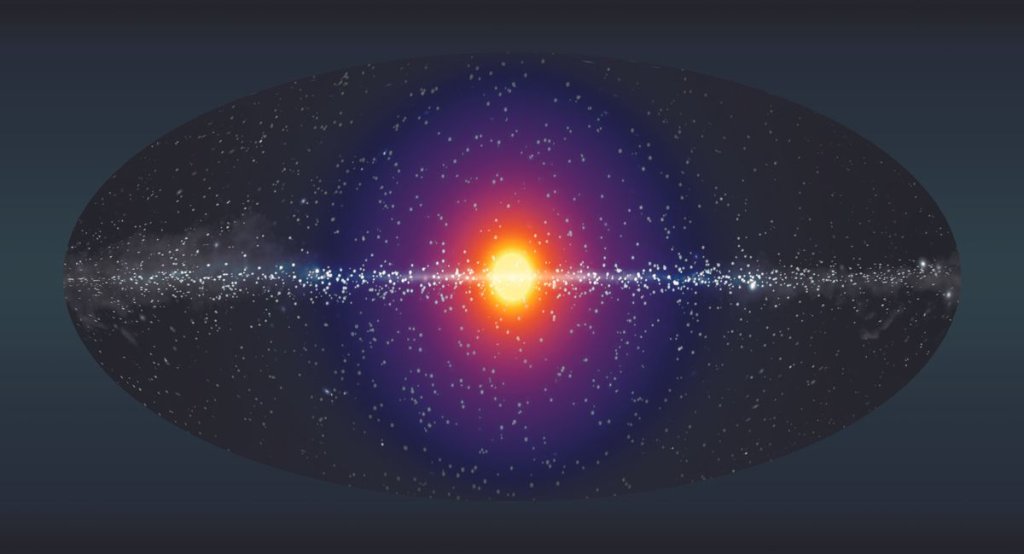
Astronomers weigh ancient galaxies’ dark matter haloes for 1st time (Image Credit: Space.com)
A team of astronomers has, for the first time, “weighed” dark matter haloes surrounding actively feeding supermassive black holes in the bright hearts of ancient galaxies.
These black hole-powered hearts, or quasars, are often brighter than the combined light of every star in the galaxies around them. These super luminous central regions are “fired up” when supermassive black holes, which can have masses billions of times that of the sun, start greedily feeding on surrounding matter.
And according to a new study, scientists suggest dark matter haloes around such active galaxies could help funnel matter toward the central black hole, acting as a cosmic delivery service helping feed the titans. This new work indicates that such a feeding mechanism was indeed at work around hundreds of ancient quasars and suggests the process is one that’s been constant throughout the history of the universe.
Related: Dark matter ‘clumps’ found by tapping into Einstein’s general relativity theory
“We measured for the first time the typical mass for dark matter halos surrounding an active black hole in the universe about 13 billion years ago,” Nobunari Kashikawa, team leader and professor at the University of Tokyo’s Department of Astronomy, said in a statement. “We find the dark matter halo mass of quasars is pretty constant at about 10 trillion times the mass of our sun. Such measurements have been made for more recent dark matter halo mass around quasars, and those measurements are strikingly similar to what we see for more ancient quasars.
“This is interesting because it suggests there is a characteristic dark matter halo mass which seems to activate a quasar, regardless of whether it happened billions of years ago or right now.”
Not only is that unexpected, but because supermassive black holes at the hearts of galaxies strongly influence the formation of stars and the growth of galaxies in general, this could have a profound impact on scientists’ understanding of how galaxies grew in the early universe and, thus, how the cosmos evolved.
Weighing up the dark matter content of ancient galaxies

The nature of dark matter is a pressing problem for science because, despite making up around 85% of all matter in our universe, it doesn’t interact with light and thus remains effectively invisible to us.
Astronomers can infer the presence of dark matter via its gravitational effects and the influence of this effect on standard everyday matter that comprises stars, cosmic dust and gas clouds, planets in galaxies as well as on light passing through those galaxies. This elusive gravitational effect ultimately led scientists to the realization that most galaxies must be wrapped in a dark matter halo of sorts. With only the gravity of visible matter within them, galaxies would not be able to hold together while rotating at great speeds.
But even as these dark matter inference techniques are refined, measuring the mass of this unseeable substance in haloes around nearby galaxies is tricky. And measuring dark matter around more distant, and thus early, galaxies has been proven more challenging because light coming from these galaxies is so faint.
Kashikawa wasn’t about to let these challenges phase him, however. He and his team wanted to better understand how black holes grew in the early universe, and thanks to the brightness of hundreds of the largest and most powerful of these supermassive black holes fueling quasars, the researchers were able to measure the dark matter haloes around ancient galaxies for the first time.
Light emanating from these ancient quasars has taken up to 13 billion years to travel the cosmos and reach over telescopes. During the epic journey, this light has lost energy, and its wavelengths have been stretched, shifting them down past the red end of the visible light spectrum and transforming them into infrared light wavelengths — a process astronomers call “redshift.”
In 2016, Kashikawa and the team started collecting infrared data from a range of astronomical surveys conducted by a variety of instruments, primarily the Subaru Telescope at the summit of Maunakea, Hawaii.
This allowed them to see how the light from these quasars had been altered by the gravitational influence of dark matter, which, like all matter with mass, warps the fabric of space and thus causes the path of light to curve — a process astronomers call gravitational lensing. Measuring the degree of warping and comparing this to the amount of warping that should arise as a result of the mass of everyday matter in the form of gas, dust and stars in these galaxies reveals the mass of hidden dark matter.
“Upgrades allowed Subaru to see farther than ever, but we can learn more by expanding observation projects internationally,” Kashikawa added. “The U.S.-based Vera C. Rubin Observatory and even the space-based Euclid satellite, launched by the EU this year, will scan a larger area of the sky and find more DMH around quasars.
“We can build a more complete picture of the relationship between galaxies and supermassive black holes. That might help inform our theories about how black holes form and grow.”
The team’s work was published Sept. 8 in The Astrophysical Journal.




